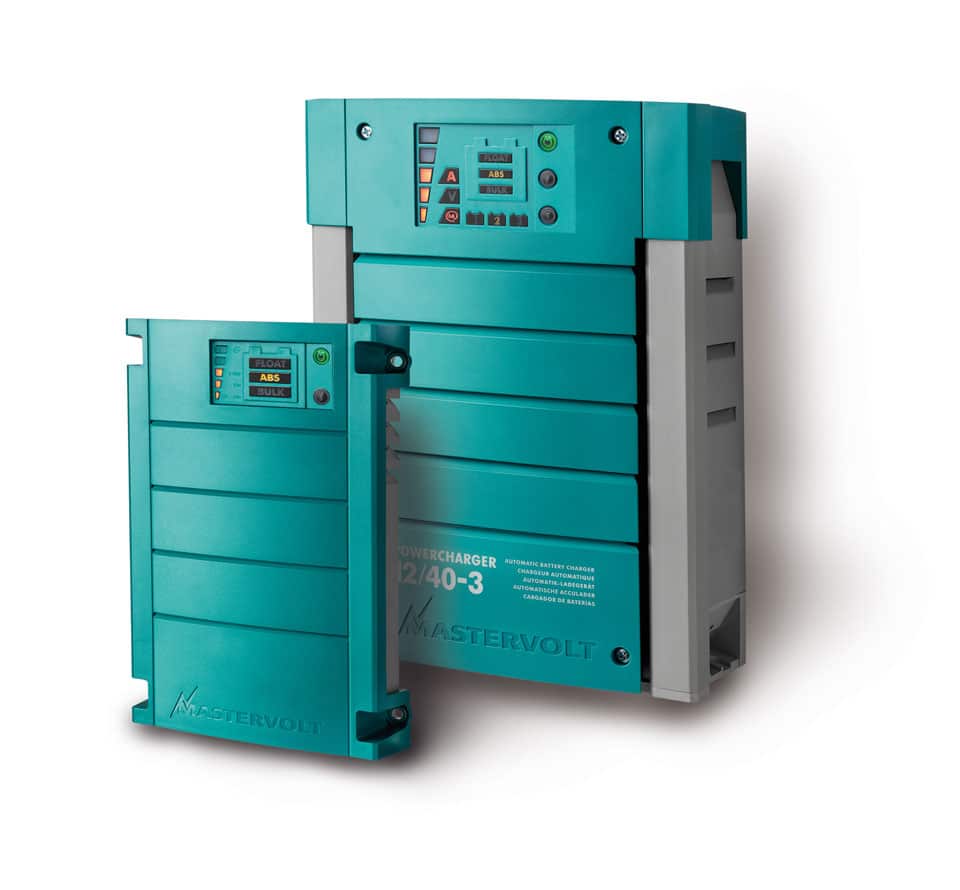
Mastervolt
The complexity of modern battery technology dictates that more sophisticated charging regimens are in order. As a result, some of the older charging systems still in use on many of the boats built in the 1970s and the 1980s may not be up to today’s tasks. Some of the older systems pose potential safety risks, while in other cases upgrades are necessary to ensure that you get that maximum return on the more efficient—and expensive—batteries that we discussed in the first installment of this series. (See “Replacing Batteries? Do Your Homework First” in CW‘s February 2012 issue.)
Shore power-supplied battery chargers aren’t our only concern here. Most engine-driven alternators found on boats employ constant-rate internal voltage regulators that are really designed and intended for conventional flooded-cell lead-acid batteries, and preferably those with serviceable cells. To truly maximize your DC system, you’re probably going to need to update your alternator and voltage regulator. Let’s walk through an assessment of these two devices one step at a time.
Assessing an Engine-Driven Alternator
If we’ve learned anything over the years, it’s that any alternator that spends the majority of its time at or near its full output potential is probably not going to last too long. Why, you ask? Simple. Alternators get hot—really hot! I’ve personally measured alternator temperatures that exceeded 200 F. Heat is the ongoing enemy of all things electrical. Too much heat causes insulation to break down, semi-conductors to fail, and, ultimately, equipment to be ruined. So it pays to overrate your needs if equipment longevity is a concern.
What that means is that your replacement alternator could easily cost well in excess of $1,000. And if you’re taking the leap, it also pays to consider alternator-temperature sensing and voltage regulation that provides automatic output step-back if the alternator reaches a conservative defined temperature. The Sterling Pro-Digital regulator, for example, will automatically step back high charge rates when the temperature exceeds 194 F. This capability becomes all the more important in light of what we know today about battery-recharge acceptance rates.
In earlier times, the inherent internal resistance of your boat’s batteries would help to keep things in check by limiting the amount of current that could be delivered from the alternator. That’s less the case today with A.G.M. and, most especially, the thin-plate pure-lead, or T.P.P.L., versions of A.G.M. batteries. Those batteries can take all the amperage you can possibly supply at a very rapid rate. While this makes for fast recharge times, it puts a heavy burden on charging equipment unless your system has temperature-sensing capability both at the batteries and the alternator. You’ll also need a voltage regulator or battery charger that reduces output when temperatures get out of hand.
To control the alternator’s temperature, choose one with a higher output rating so the alternator doesn’t work as hard. It will indeed run cooler if it’s not constantly running at full output. I typically like to size electrical-system components once a DC load analysis has been done for a boat to ensure that an alternator is running most of the time at no more than 70 percent to 75 percent of its rated output.
Installing New Components
Now that you’ve decided to upgrade to the 200-amp-hour-rated alternator of your dreams, what else do you need to consider?
Alternators consume engine power. A rough guideline used in making calculations is that 1 horsepower equals 746 watts. Amperage multiplied by voltage equals watts, so using the 200-amp example at 12 volts, we see that it’s going to take a little over 3 horsepower to run the alternator.
If your boat is running a 7-horsepower, single-cylinder diesel engine as an auxiliary, you may want to think of another way to generate more electric power. Most modern cruising boats run engines of 30 horsepower or more, so this isn’t as much of a problem these days. What may be a problem, however, is that once you get over about a 100-amp alternator, you’re going to need to run a double pulley system to prevent belt slippage. This requires you to replace all of the pulleys on the front of your engine. Check with your engine manufacturer to be sure this isn’t going to be a problem. Also, you need to carefully compare mounting-bolt locations and spacing to make certain that you’re not going to need a custom mounting bracket for the new alternator and that the new unit will actually fit on your engine without interfering with other engine-mounted components. Don’t forget the clearance for the front crankshaft pulley, either. Is there enough room in your engine bed to accommodate a wider front pulley without interfering with the engine bed and any crossbar that may be installed as part of the engine-mounting arrangement?
If you have a newer engine with a flat serpentine belt, you should be OK with the stock pulley system up to an alternator rated at about 150 amps. After that, you may be out of luck if you want more output, because finding an oversized serpentine pulley set and matching belt of the right length isn’t going to be easy. Check with both the alternator and engine manufacturer on the availability of the needed parts. Balmar, for one, offers a fairly comprehensive line of pulley and custom alternator-mounting kits as well as optional temperature-sensing, programmable voltage regulators and wiring kits for its alternator product line.
Next, you need to consider the wiring used in your original alternator/regulator system. It’s undoubtedly going to need to be up-sized to accommodate the increased amperage that your new system is capable of providing.
One last potential problem concerns your engine’s tachometer. Often, a diesel engine’s tachometer is driven by a signal generated at the original-equipment alternator. You must determine if there’s compatibility with your new high-output unit or if you’ll need a different tachometer-rpm signal source.
Clearly, upgrading to a new high-output alternator may not be a simple Saturday-morning D.I.Y. project; rather, it’s one that comes with a price. You really should think about your cruising needs and whether the payback is going to be worth it.
Managing Multiple Batteries
Even the smallest modern cruising boat is going to have at least two batteries as its DC power source; in fact, most sailboats will have more. So it’s worth taking a look at some of the components available to more effectively isolate and recharge multiple batteries or groups of batteries as well as to assist in ensuring that a proper regimen for recharging is available when and if you do decide to move up to a higher-output, externally regulated alternator system. Or perhaps you want to integrate into the mix an alternative energy source, such as a solar panel or a wind generator. Today’s solid-state technology offers us some excellent tools to do the job with greater precision.
Take the ProIsoCharge unit from ProMariner as an example. This device automatically provides dedicated isolation for your engine starting battery so it can’t go dead if you forget to switch to the dedicated house battery at anchor. The IsoCharge runs at zero-percent voltage drop, unlike traditional diode-type battery isolators, so there’s no loss of charging capability due to excessive voltage drop. Depending on the model, you can effectively service up to four separate battery banks.
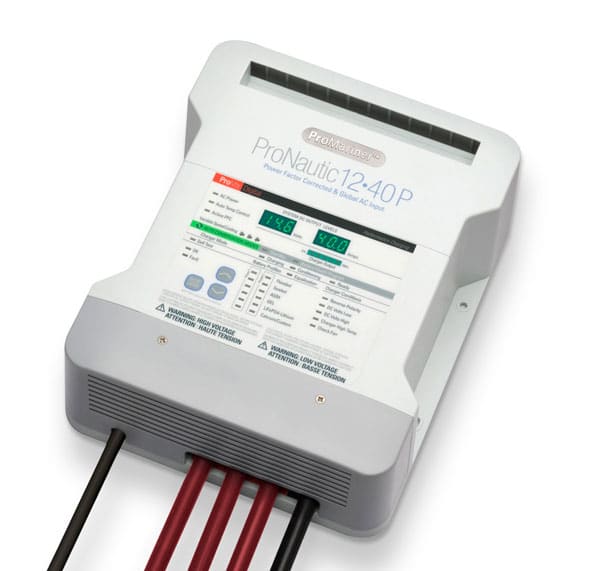
L.E.D. lights on the ProNautic charger indicate a battery’s charging status.
The unit gets installed between the charging source and multiple battery banks. It’s activated via your boat’s ignition switch, and as soon as it’s powered up, it automatically monitors each of the battery banks connected to it. It begins with the start battery and charges it up to a 13.3-volt level, then moves on to subsequent batteries. Once all are brought up to 13.3 volts, all are brought back online and charged until they’re at 100-percent capacity, typically somewhere between 13.8 to just over 14 volts, depending on battery chemistry.
If a heavy load such as a bow thruster pulls down one bank below the others, the system automatically diverts charging power to that bank until it reaches parity. The device automatically prevents any back-feeding between banks. The IsoCharge can also be used as an effective charge-distribution center for solar panels or a wind generator. Sterling Power Products offers a device known as a battery-to-battery charger that works in a similar way.
Controlling Voltage
Sterling Power Products’ Pro-Digital voltage regulator is billed by the company as the “most powerful and advanced alternator regulator currently available in the world.” I’m reasonably certain that there are folks at Balmar and Ample Power that would want to argue that point.
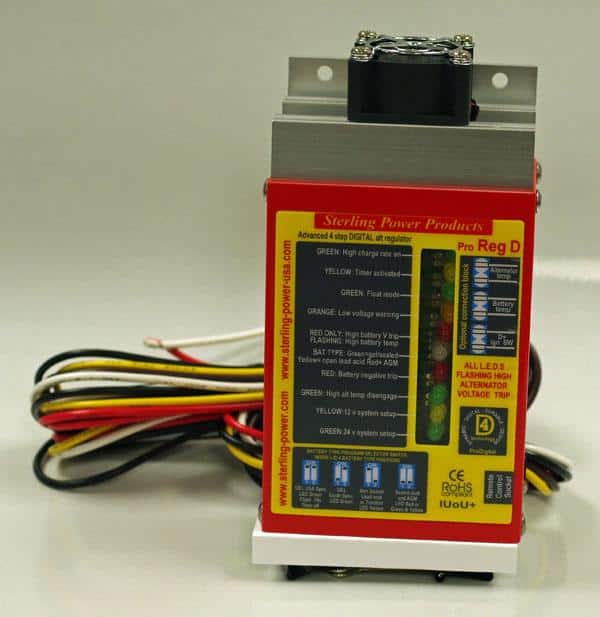
Sterling Power Products’ powerful, versatile Pro-Digital voltage regulator can be programmed to service both 12- volt and 24-volt battery banks.
Regardless, relying on the constant-rate integral voltage regulator that came with your engine will earn you a charge of gross negligence against your new high-tech batteries. To maximize your battery return on investment, you need a programmable voltage regulator and will want to set up temperature monitoring at least at the batteries and, if you’re using a high-output unit, preferably at both the batteries and the alternator. The Pro-Digital regulator offers output settings for a range of batteries: conventional flooded-cell batteries, on which you have cell access for topping up depleted electrolyte; sealed flooded and certain A.G.M. batteries; and some gel-cell models. There’s also an additional setting for other gel or A.G.M. batteries, depending upon the battery manufacturer’s specific voltage requirements. It also has inputs for temperature sensors. The software within the regulator automatically calculates the battery-bank size, charge state, and alternator output, and it sets the microprocessor to adjust appropriate charge phase-time durations.
Better Battery Chargers
Over the last 10 years, we’ve seen significant advances in battery chargers. I think the operative phrase here is “programmability.” The digital age has brought us charger output-programming functionality that we’ve lacked. Digital controls and high-frequency switch-mode power supplies have enabled engineers to develop more sophisticated, lighter, and more reliable battery chargers that run cooler and can truly meet the needs of our new generation of batteries.
Mastervolt’s 12-20/3 PowerCharger, for example, weighs in at a mere 4 pounds—less than a third of the weight of chargers using older technology.
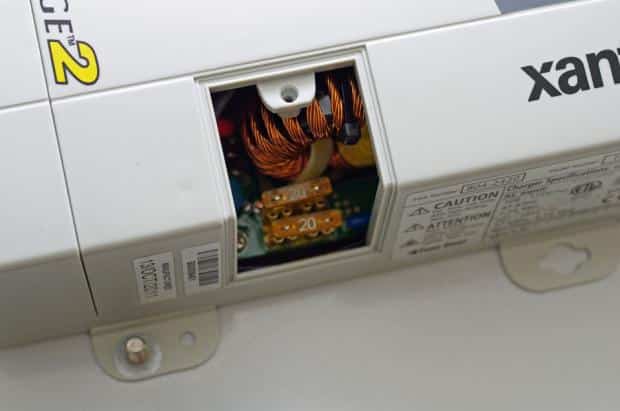
The Xantrex True-Charge2 offers easy access to its output fuses and has DC power-output studs for multiple battery banks.
For me, the selection of a new-tech battery charger boils down to choosing a unit that has a feature set that matches the needs of the batteries I’ve selected and comes with a reasonable warranty. The charger should have a compact form and a low weight-to-output ratio. All the new chargers I’ve looked at meet these requirements, but to varying degrees. Warranties, for example, range from two years for Mastervolt and Xantrex products to three years for the Charles IMC and five years for the ProMariner lineup.
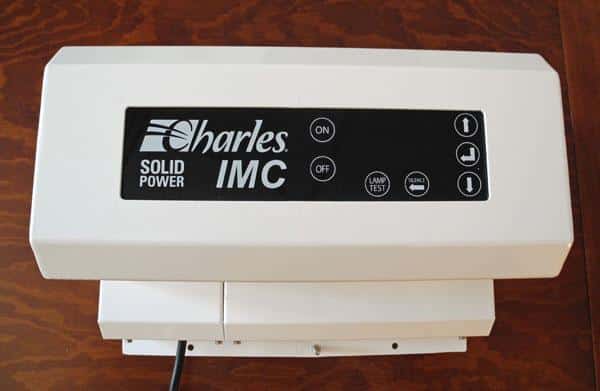
The Charles IMC is a fully programmable charger and can handle up to four battery banks. Its Smart Memory Button retains the unit’s settings and can be transferred, should the charger fail.
But equally important, I think, is the real-world availability of warranty service, should it be needed. The Mastervolt PowerCharger is available exclusively through West Marine stores, so here in the United States, that means broad availability, at least in coastal areas. The bottom line with any warranty is often not the duration but, rather, the true availability of warranty service wherever you’re located. It pays to ask about the details of any warranty and the size and scope of any existing dealer network.
In terms of feature sets, decisions are a bit tougher to make, because there are many similarities among the units we looked at. In the end, I think it boils down to some serious nitpicking that I suspect most boat owners aren’t going to be willing to bother with.
Promariner and Sterling Power Products, for example, offer battery-temperature sensors as standard equipment; I applaud them for that. Charles Industries, Mastervolt, and Xantrex have them available, but they’re optional. But how do actual costs compare? I didn’t compare prices as part of this review, but you should if you’re in the market for these types of products.
The Charles IMC charger offers several unique features. One is what the company calls its Smart Memory Button. This removable memory disk stores all of the configuration values once initial programming is completed. In the event of unit failure, this button can be transferred from one unit to a replacement, and reconfiguration will be unnecessary. On the 40-amp and higher models, a “limp home” mode is available in the event that one of the power modules fails, for whatever reason. In this day and age of total reliance on electronics, this strikes me as a prudent feature. Another unique feature is a selectable voltage output that allows for nominal 12-volt or 24-volt output by battery bank. This is a possible game changer on some midsize to large boats that may have both 12-volt and 24-volt DC systems installed. The IMC charger would preclude the need for buying a separate charger for each system, a big potential saving.
Other details to examine are specific to the power supply, which is very important to those with global cruising aspirations. What are the frequency and voltage operating parameters for AC input to the charger? All of the companies mentioned here offer full global coverage with their products, so that isn’t a problem, but not all brands offer such coverage, so it’s something to note.
When it comes to safety, look for auto-shutdown features that turn off the charger when temperatures get too high for comfort. This is important from the perspective of both safety as well as battery longevity, and with digital controls it’s a really nice “new-tech” capability.
How Big a Charger Do I Need?
Finally, you’ll need to answer one basic question before you make your final choice of battery charger: How much capacity should it have—20 amps, 40 amps, 60 amps? There are no hard and fast rules here, and in fact the rules change as battery recharge-acceptance rates improve. Here’s my advice: Decide how many battery banks you need to service. All of the chargers mentioned in this article, for example, have between three- and four-bank capability. Obviously, the output voltage of the charger needs to match the battery bank it’s servicing. As for amperage output, your charger’s amperage capacity should be between 25 percent and 50 percent of your battery bank’s capacity in amp-hours. Flooded cells will be nearer the 25-percent end of the spectrum; A.G.M.s will be nearer the 50-percent end. With gel-cells, I follow the manufacturer’s guidelines to the letter.
Electrical-Equipment Manufacturers
Ample Power Co.: (206) 789-0827
Balmar: (360) 435-6100
Charles Industries: (847) 806-6300
Mastervolt USA: (207) 354-0618
ProMariner: (603) 433-4440
Sterling Power USA: (207) 226-3500
Xantrex: (800) 446-6180
Ed Sherman is the educational programming director for the American Boat & Yacht Council. Read his frequent blog posts in Ed’s Boat Tips.








